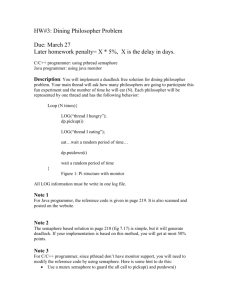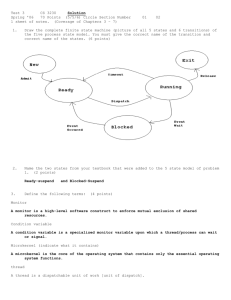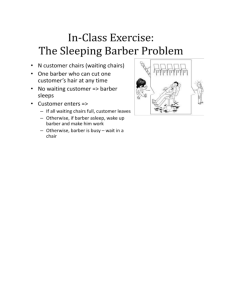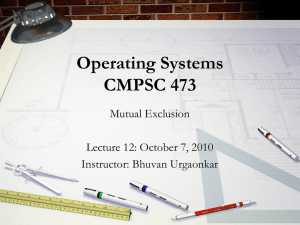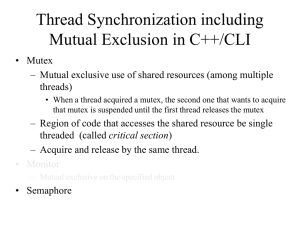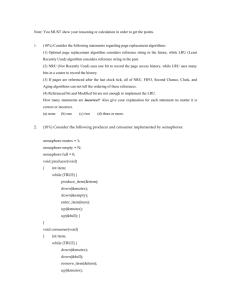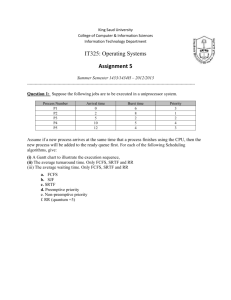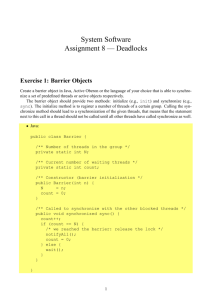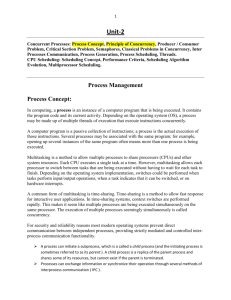Mock exam
advertisement
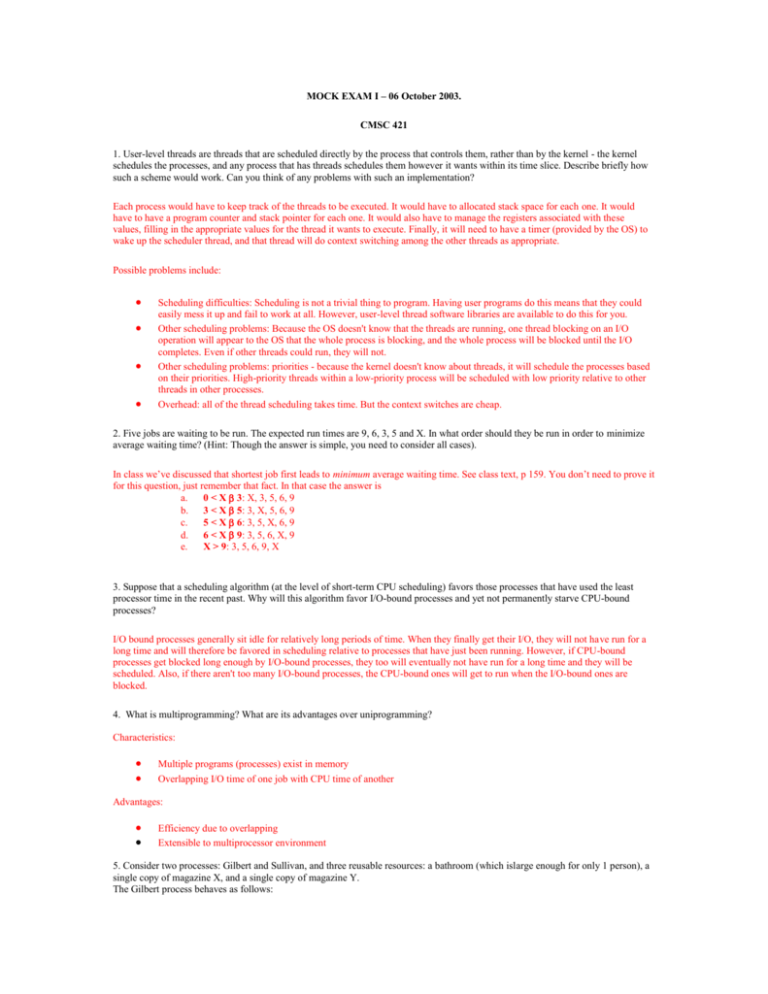
MOCK EXAM I – 06 October 2003. CMSC 421 1. User-level threads are threads that are scheduled directly by the process that controls them, rather than by the kernel - the kernel schedules the processes, and any process that has threads schedules them however it wants within its time slice. Describe briefly how such a scheme would work. Can you think of any problems with such an implementation? Each process would have to keep track of the threads to be executed. It would have to allocated stack space for each one. It would have to have a program counter and stack pointer for each one. It would also have to manage the registers associated with these values, filling in the appropriate values for the thread it wants to execute. Finally, it will need to have a timer (provided by the OS) to wake up the scheduler thread, and that thread will do context switching among the other threads as appropriate. Possible problems include: Scheduling difficulties: Scheduling is not a trivial thing to program. Having user programs do this means that they could easily mess it up and fail to work at all. However, user-level thread software libraries are available to do this for you. Other scheduling problems: Because the OS doesn't know that the threads are running, one thread blocking on an I/O operation will appear to the OS that the whole process is blocking, and the whole process will be blocked until the I/O completes. Even if other threads could run, they will not. Other scheduling problems: priorities - because the kernel doesn't know about threads, it will schedule the processes based on their priorities. High-priority threads within a low-priority process will be scheduled with low priority relative to other threads in other processes. Overhead: all of the thread scheduling takes time. But the context switches are cheap. 2. Five jobs are waiting to be run. The expected run times are 9, 6, 3, 5 and X. In what order should they be run in order to minimize average waiting time? (Hint: Though the answer is simple, you need to consider all cases). In class we’ve discussed that shortest job first leads to minimum average waiting time. See class text, p 159. You don’t need to prove it for this question, just remember that fact. In that case the answer is a. 0 < X 3: X, 3, 5, 6, 9 b. 3 < X 5: 3, X, 5, 6, 9 c. 5 < X 6: 3, 5, X, 6, 9 d. 6 < X 9: 3, 5, 6, X, 9 e. X > 9: 3, 5, 6, 9, X 3. Suppose that a scheduling algorithm (at the level of short-term CPU scheduling) favors those processes that have used the least processor time in the recent past. Why will this algorithm favor I/O-bound processes and yet not permanently starve CPU-bound processes? I/O bound processes generally sit idle for relatively long periods of time. When they finally get their I/O, they will not have run for a long time and will therefore be favored in scheduling relative to processes that have just been running. However, if CPU-bound processes get blocked long enough by I/O-bound processes, they too will eventually not have run for a long time and they will be scheduled. Also, if there aren't too many I/O-bound processes, the CPU-bound ones will get to run when the I/O-bound ones are blocked. 4. What is multiprogramming? What are its advantages over uniprogramming? Characteristics: Multiple programs (processes) exist in memory Overlapping I/O time of one job with CPU time of another Advantages: Efficiency due to overlapping Extensible to multiprocessor environment 5. Consider two processes: Gilbert and Sullivan, and three reusable resources: a bathroom (which islarge enough for only 1 person), a single copy of magazine X, and a single copy of magazine Y. The Gilbert process behaves as follows: get magazine Y get magazine X release Y get bathroom release X release bathroom The Sullivan process behaves as follows: get magazine X get magazine Y release X release Y get bathroom release bathroom Each process is asynchronous and repeats its behavior cycle indefinitely. 1. Using semaphores, implement appropriate synchronization for these processes in a multiprogramming environment. Try to achieve the maximum utilization of each resource. You are not allowed to change the order in which any operations are performed (Gilbert and Sullivan are very stubborn). The resulting system must be deadlock free. Use P and V instead of wait and signal in order to save time writing your solution. 2. Show that your solution implements mutual exclusion with respect to the magazine X. 3. Outline an informal argument that deadlock is not possible in your solution. semaphore MUTEX = 1; semaphore BATHROOM = 1; semaphore X, Y = 1; The Gilbert process: Repeat P(MUTEX) P(Y) P(X) V(MUTEX) V(Y) P(BATHROOM) V(X) V(BATHROOM) until false The Sullivan process: Repeat P(MUTEX) P(X) P(Y) V(MUTEX) V(X) V(Y) P(BATHROOM) V(BATHROOM) until false To get magazine X, each process has to get the semaphore MUTEX first, so if the MUTEX semaphore can't be possessed by two processes at the same time, we can guarantee the mutual exclusion of magazine X. In fact, since MUTEX is initialized to 1, only one process has the access to it at the same time. Suppose these processes will deadlock. Then both the Gilbert process and the Sullivan process hold one semaphore and request the other one held by the other process. However, according to the pseudocode, such situation can never happen. 6. Is the following system deadlocked. If not, indicate how it is not deadlocked by giving a sequence of process executions. Allocation Request ABC ABC p0 0 1 0 0 0 0 p1 2 0 0 2 0 2 p2 3 0 3 0 0 0 p3 2 1 1 1 0 0 p4 0 0 2 0 0 2 Available ABC 0 0 0 No deadlock with the sequence (p0; p2; p3; p1; p4). Other sequences are also possible.

